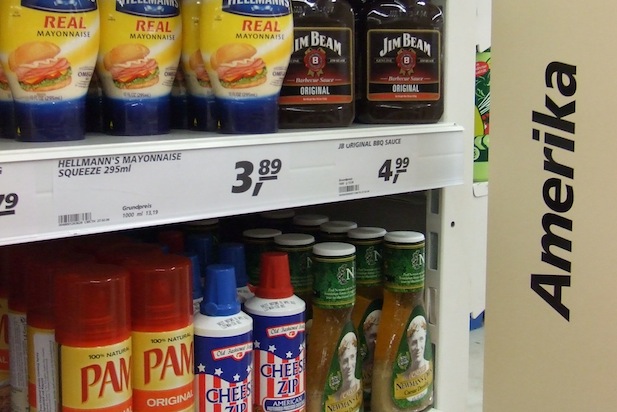Thoughts From the Amerika Section of a German Grocery Store
Travel Stories: Amid the Cheese Zip and the Marshmallow Fluff, Terry Ward remembers what it means to be American
10.11.10 | 11:01 AM ET
 By Terry Ward
By Terry WardMy friend Hannah, a Pennsylvanian transplanted to Hamburg, Germany, posted this caption with a photo on her Facebook wall:
“People, this is what makes a country great.”
The great country she referred to was America. And the photo inspiring Hannah’s sentiment was this bag of candy corn-flavored Hershey’s Kisses she’d spotted during a trip back to the States:

I knew exactly what Hannah meant. Unusual eats like the aforementioned are part of our American ingenuity.
Still, what counts as American food has always confused me. And, American mutt that I am, it’s a question that becomes all the more perplexing when I’m faced with it abroad.
Typically, when asked to create an American meal for friends in other countries, I revert to an abbreviated version of Thanksgiving dinner. Or, more often, something Mexican, like chips and salsa and burritos (all the while assuring them it’s a very American meal, while secretly craving cream-cheese-spiked and tempura-fried sushi—the “American” food I miss most when away from home for prolonged periods).
What’s “American” to us can be so personal. I’m the first to defend the inherent greatness of a peanut butter and jelly sandwich to the most uppity French epicurean. But I was struck with mixed emotions recently—most disarmingly, a feeling of cultural rootlessness—while perusing the section labeled Amerika in the international food aisle of Real, a mega grocery store in Hamburg.
The Amerika section was right next to the Turkish and Russian sections, with their arrays of pickled vegetables, vodkas, Moldavian wine and tinned fish, canned olives and bags of bulgur and couscous.
And as much as I struggle with the concept myself, what this grocery story in Germany had deemed typical American foods had me feeling combative.
A yellow can presented as an integral food of my nation was labeled rather ominously, Sprühfett mit Rapsöl. It was PAM, the cooking spray that many a harried American meal maker is prone to wield like a can of insect repellent against pesky non-nonstick pans.
I scanned the other shelves. I found barbecue sauce, squeeze cheese (jalapeño and nacho-flavored), an array of Hershey’s products, and marshmallows in various incarnations, including Swiss Miss Hot Chocolate Marshmallow Lovers, with the box trumpeting a sentiment as all-American as it gets: “As much calcium as an 8 oz. glass of milk!”
Jars of Marshmallow Fluff lined the bottom shelf, with cans of Campbell’s Tomato Soup above and a spread of condiments that included Hellmann’s Mayonnaise and Newman’s Own Caesar Dressing.
Betty Crocker’s boxed mixes of blueberry muffins, brownies and Chocolate Chocolate Chip Muffin Mix went for a hefty 4.99 euros apiece. And a box of “Parade” powdered macaroni and cheese masqueraded as a Kraft original.
There in the most patriotic packaging of all—I practically expected it to start billowing in the breeze for all its stars and stripes—was something called Cheese Zip, sporting a banner on its can claiming “Old Fashioned Foods.”
It’s Easy Cheese, I wanted to yell out to the whole of the international food aisle, not Cheese Zip, feeling conflicted that I cared. Das ist verboten! If you’re going to include the stuff and say it represents my country, at least make sure it’s the real deal.
My sister has gotten Easy Cheese and not some impostor in her stocking every Christmas since we were kids. We sprayed it directly into our mouths or atop Triscuits and Saltines (also notably absent from the Amerika section).
But how were the Germans supposed to know the intricacies of American food culture, when most often it’s viewed as something readily replaceable? A calorie-laden novelty, pre-packaged and pushed at them (and at the rest of the world, for that matter) in the form of one convenience product or fast food chain after another.
Then I reminded myself that this wasn’t America, it was Amerika.
Surely the German aisle in my own imaginary American grocery store would have appeared equally cliché, all pretzels and bread rolls and bratwursts. You can’t know a culture without knowing its food, something that requires time and immersion. And it occurred to me that for all the people in the world who only know the U.S. through its brands and reality shows and brash marketing schemes, America’s true identity had to be one of the most elusive of all.
The German grocery store’s interpretation of typical American food wasn’t quite right, but that didn’t mean I was able to define it any better myself, not to mention condense it into a few shelves in a dry-foods section.
Perhaps it takes coming to places like Amerika to remember that part of being American means belonging to everywhere and nowhere.
I might never have eaten the stuff back home, but I grabbed a jar of Strawberry Fluff and made for the check-out line, somehow feeling better already.![]()